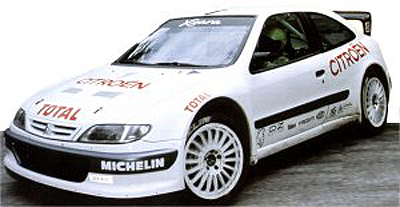Xsara WRC
To the untrained
eye, this white Xsara looks like a kit car But this is a
vehicle of a different ilk It sounds different: the kit cat's
metallic roar has been replaced by a harsh throbbing noise
with muffled detonations. It looks different, being smaller
and narrower than a kit car, although the black-carbon rear
spoiler is bigger. And when it negotiates hairpin bends, it
drifts slightly at the rear before taking off again like a
bullet - because it is fitted with four-wheel drive. This
Xsara is a World Rally Car.
|
 |
|
Why a WRC?
The Xsara Kit Car
managed to beat the WRCs twice in a row. So why develop a WRC
version of the Xsara? The first reason is that the
International Federation has increased the minimum weight of
kit cars by 40 kg. Second, although two-wheel drives are
impressive performers on tarmac, they cannot cope with greasy
or muddy surfaces, and so have no chance of winning dirt-track
events. For this reason, Guy Fréquelin, head of Citroën Sport,
set his team (leaders in long-distance rallies and kit cars) a
third ambitious challenge: to design a WRC.
The vehicle's
body shell has been modified. The overall width has been
reduced to 1.770 mm, the maximum allowed for WRCs, while
shafts, axles and other components transmit power to the rear
wheels.
The WRC engine is
based on that of the Xsara 1.8i 16V The aluminium engine block
has been modified to make room for a Garrett turbocharger. The
turbocharger has a 34 mm diameter restrictor to limit the air
intake and by extension, the power. Citroën has a key
advantage in this field, with its experience in long-distance
rallies (high operating temperatures, fresh-air systems,
post-combustion, etc.).
With respect to
the transmission system, Guy Fréquelin explained: ?We had
enough room to keep the gearbox in its current position. This
saved weight because we didn?t have to fit the transmission
components at 90º - something that would have been required by
a longitudinal gearbox."
A guided tour
of the WRC
The four-wheel
drive system was designed by Citroën Sport and manufactured by
UK specialist X-Trac. An original feature: a second
Magneti Marelli M3 computer, identical to the one processing
engine data, manages the elec-tronic differentials.
The Xsara WRC is
fitted with four McPherson struts. For the shock absorbers,
Citroën is continuing its successful partnership with Dynamic.
The Citroën team has a special advantage in this respect: the
extensive know-how gained in long-distance rallies on
shock-absorption systems for heavy vehicles.
Says Guy
Frequelin: ?The Xsara has some major advantages. It is not
big, but it has enough room to house all the components of a
WRC. It has no overhang, but the wheelbase guarantees
stability. We still have a lot of work to do on the
suspension, the transmission of drive to the electronic
differentials, mass centring, etc." Being given a WRC to drive
24 hours after winning in Corsica (in 1999) was a great
reward!" exclaimed Philippe Bugalski. ?It meant I was
able to clock up 200 km before the public holiday on 13
May. The WRC is an ?easier? drive than the kit
car. It doesn?t need the same aggressive, physical kind
of driving, so it was easier to switch from the kit car to the
WRC rather than the other way round. The most
tiring feature is the heat produced by the turbo. In two days,
we looked at a whole range of issues and made real progress.
The car is easy to drive and I didn't feel at all restricted
by its weight. There is still a lot of work to do and
comparisons to make, but I reckon we're off to a good start."
Background
At one stage, it
looked as though the World Rally Championship would bow to
pressure from French carmakers and reserve the competition for
21 FWD models. Authorisations were to include bodywork
modifications (e.g inclusion of 650 mm diameter wheel arches),
and non-restricted intake and exhaust systems. The specific
parts were bundled into a kit, which had to be produced in 20
examples. This was how the vehicles earned the name "kit car".
Makers of
four-wheel drive cars were quick to protest. In a bid to find
a compromise. a group of people, including Guy Fréquelin,
suggested authorising the construction of turbocharged 4WDs
using 2WD models. The World Rally Cars, also avail-able in 20
homologated examples. were born.
|



